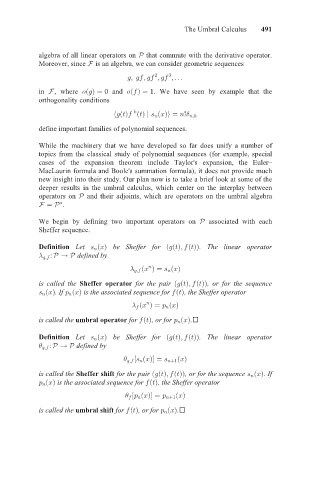Page 507 - Advanced Linear Algebra
P. 507
The Umbral Calculus 491
algebra of all linear operators on that commute with the derivative operator.
F
Moreover, since is an algebra, we can consider geometric sequences
<
Á Á Á Á Ã
in < , where ² ³ ~ and ² ³ ~ . We have seen by example that the
orthogonality conditions
º ²!³ ²!³ ²%³» ~ [ Á
define important families of polynomial sequences.
While the machinery that we have developed so far does unify a number of
topics from the classical study of polynomial sequences for example, special
(
cases of the expansion theorem include Taylor's expansion, the Euler–
)
MacLaurin formula and Boole's summation formula , it does not provide much
new insight into their study. Our plan now is to take a brief look at some of the
deeper results in the umbral calculus, which center on the interplay between
operators on and their adjoints, which are operators on the umbral algebra
F
< F ~ i .
We begin by defining two important operators on F associated with each
Sheffer sequence.
Definition Let ²%³ be Sheffer for ² ²!³Á ²!³³ . The linear operator
F Á ¢ F ¦ defined by
Á ²% ³ ~ ²%³
is called the Sheffer operator for the pair ² ²!³Á ²!³³ , or for the sequence
²%³. If ²%³ is the associated sequence for ²!³, the Sheffer operator
²% ³ ~ ²%³
is called the umbral operator for ²!³ , or for ²%³ .
Definition Let ²%³ be Sheffer for ² ²!³Á ²!³³ . The linear operator
F Á ¢ F ¦ defined by
Á ´ ²%³µ ~ b ²%³
is called the Sheffer shift for the pair ² ²!³Á ²!³³ , or for the sequence ²%³ . If
²%³ is the associated sequence for ²!³, the Sheffer operator
´ ²%³µ ~ ²%³
b
is called the umbral shift for ²!³ , or for ²%³ .


